hood open MERCEDES-BENZ SPRINTER 2017 MY17 Operator’s Manual
[x] Cancel search | Manufacturer: MERCEDES-BENZ, Model Year: 2017, Model line: SPRINTER, Model: MERCEDES-BENZ SPRINTER 2017Pages: 286, PDF Size: 4.36 MB
Page 14 of 286
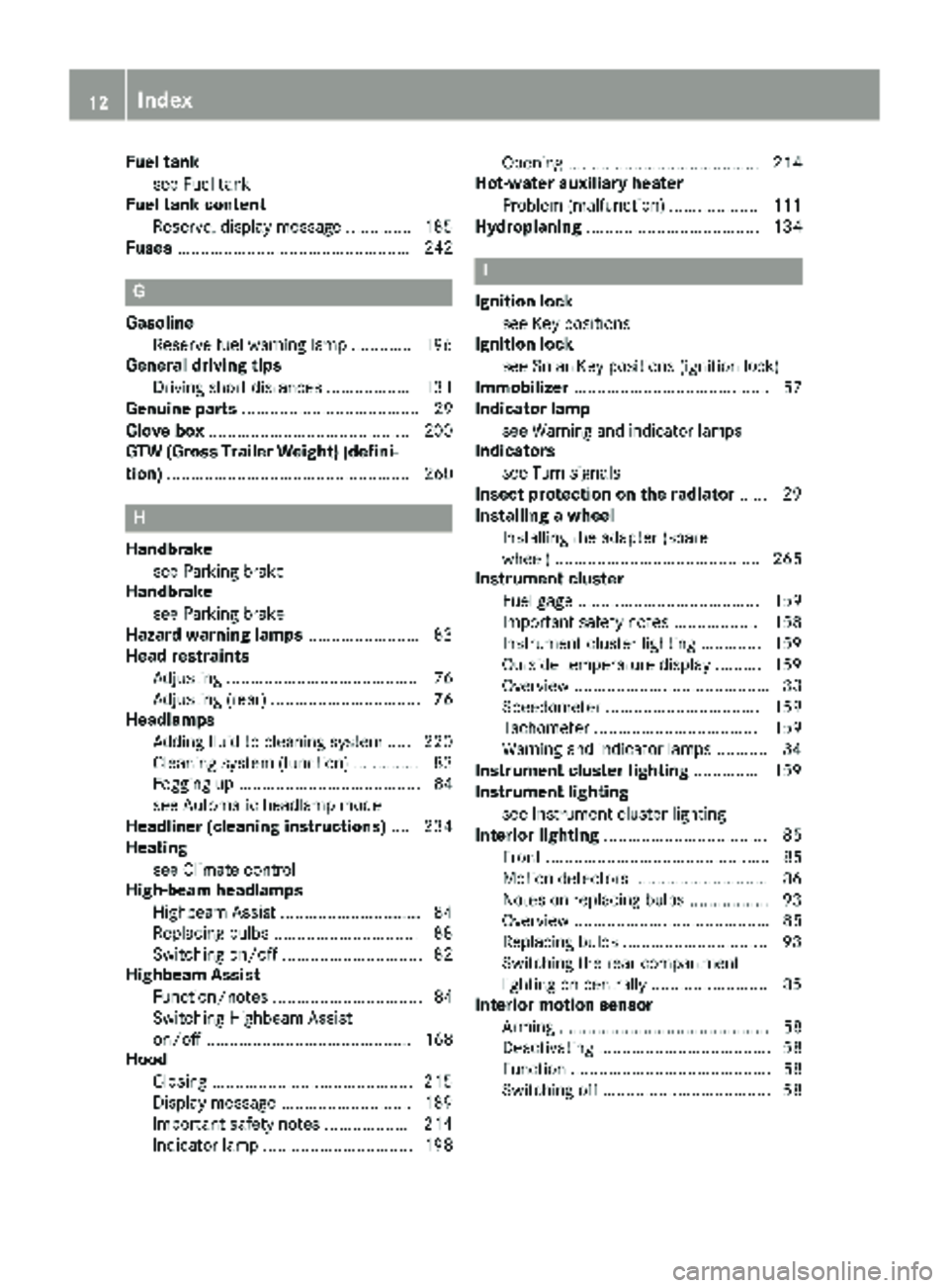
Fuel tanksee Fuel tank
Fuel tank content
Reserve, display message .............. 185
Fuses .................................................. 242
G
Gasoline
Reserve fuel warning lamp ............ .196
General driving tips
Driving short distances .................. 131
Genuine parts ...................................... 29
Glove box ...........................................2 00
GTW (Gross Trailer Weight) (defini-
tion) .................................................... 260
H
Handbrake
see Parking brake
Handbrake
see Parking brake
Hazard warning lamps ........................ 83
Head restraints
Adjusting ......................................... 76
Adjusting (rear) ................................ 76
Headlamps
Adding fluid to cleaning system ..... 220
Cleaning system (function) .............. 83
Fogging up ....................................... 84
see Automatic headlamp mode
Headliner (cleaning instructions) .... 234
Heating
see Climate control
High-beam headlamps
Highbeam Assist .............................. 84
Replacing bulbs ............................... 88
Switching on/off .............................. 82
Highbeam Assist
Function/notes ................................ 84
Switching Highbeam Assist
on/off ............................................ 168
Hood
Closing ...........................................2 15
Display message ............................ 189
Important safety notes .................. 214
Indicator lamp ................................ 198 Opening ......................................... 214
Hot-water auxiliary heater
Problem (malfunction) ................... 111
Hydroplaning ..................................... 134
I
Ignition lock
see Key positions
Ignition lock
see SmartKey positions (ignition lock)
Immobilizer .......................................... 57
Indicator lamp
see Warning and indicator lamps
Indicators
see Turn signals
Insect protection on the radiator ...... 29
Installing a wheel
Installing the adapter (spare
wheel) ............................................ 265
Instrument cluster
Fuel gage ....................................... 159
Important safety notes .................. 158
Instrument cluster lighting ............. 159
Outside temperature display .......... 159
Overview .......................................... 33
Speedometer ................................. 159
Tachometer ................................... 159
Warning and indicator lamps ........... 34
Instrument cluster lighting .............. 159
Instrument lighting
see Instrument cluster lighting
Interior lighting ................................... 85
Front ................................................ 85
Motion detectors ............................. 86
Notes on replacing bulbs ................. 93
Overview .......................................... 85
Replacing bulbs ............................... 93
Switching the rear compartment
lighting on centrally ......................... 85
Interior motion sensor
Arming ............................................. 58
Deactivating ..................................... 58
Function ........................................... 58
Switching off .................................... 58
12Index
Page 34 of 286
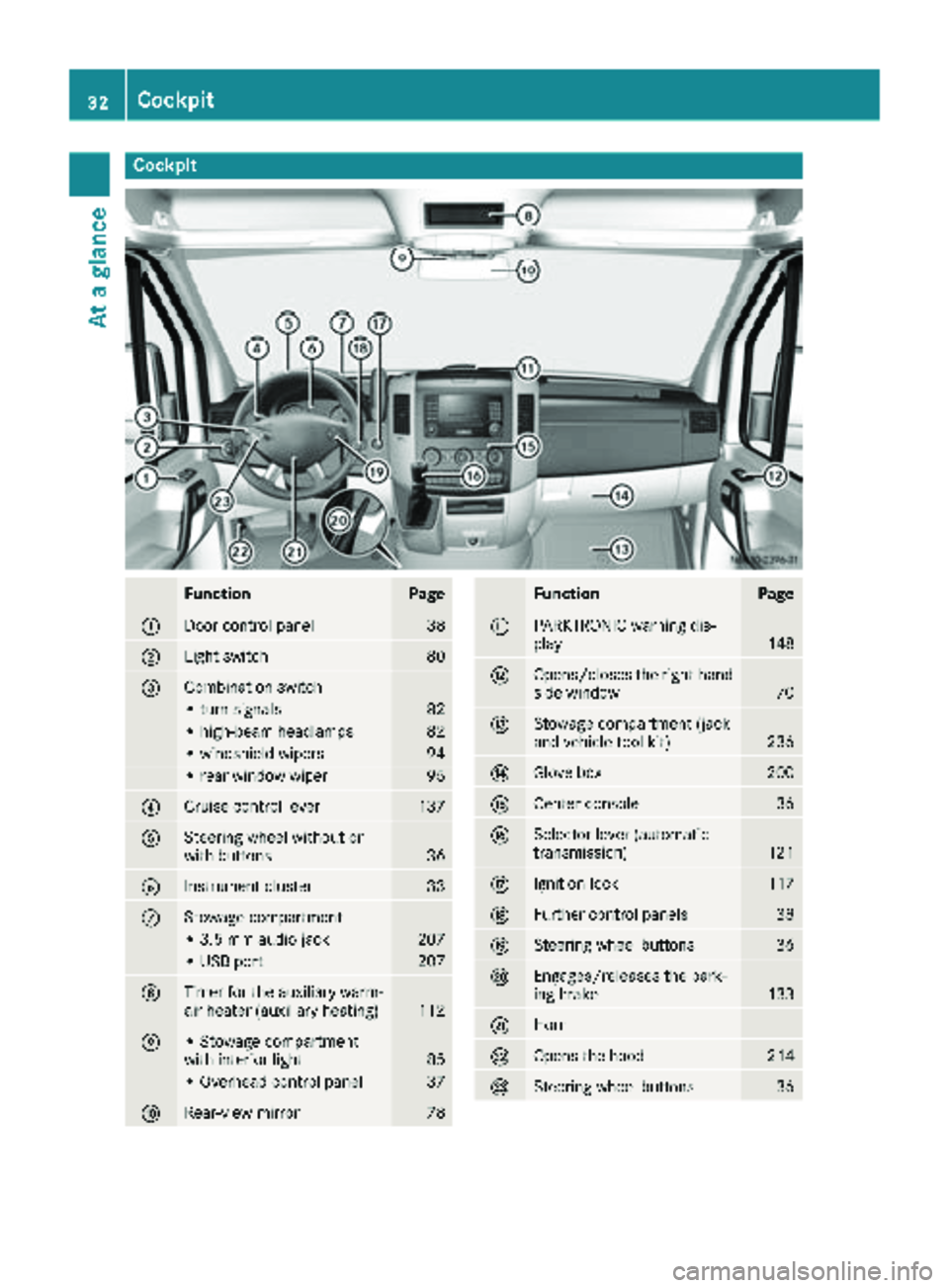
Cockpit
FunctionPage
:Door control panel38
;Light switch80
=Combination switch
• turn signals82
• high-beam headlamps82
• windshield wipers94
• rear window wiper95
?Cruise control lever137
ASteering wheel without or
with buttons36
BInstrument cluster33
CStowage compartment
• 3.5 mm audio jack207
• USB port207
DTimer for the auxiliary warm-
air heater (auxiliary heating)112
E• Stowage compartment
with interior light85
• Overhead control panel37
FRear-view mirror78
FunctionPage
GPARKTRONIC warning dis-
play148
HOpens/closes the right-hand
side window70
IStowage compartment (jack
and vehicle tool kit)236
JGlove box200
KCenter console36
LSelector lever (automatic
transmission)121
MIgnition lock117
NFurther control panels38
OSteering wheel buttons36
PEngages/releases the park-
ing brake133
QHorn
ROpens the hood214
SSteering wheel buttons36
32Cockpit
At a glance
Page 37 of 286
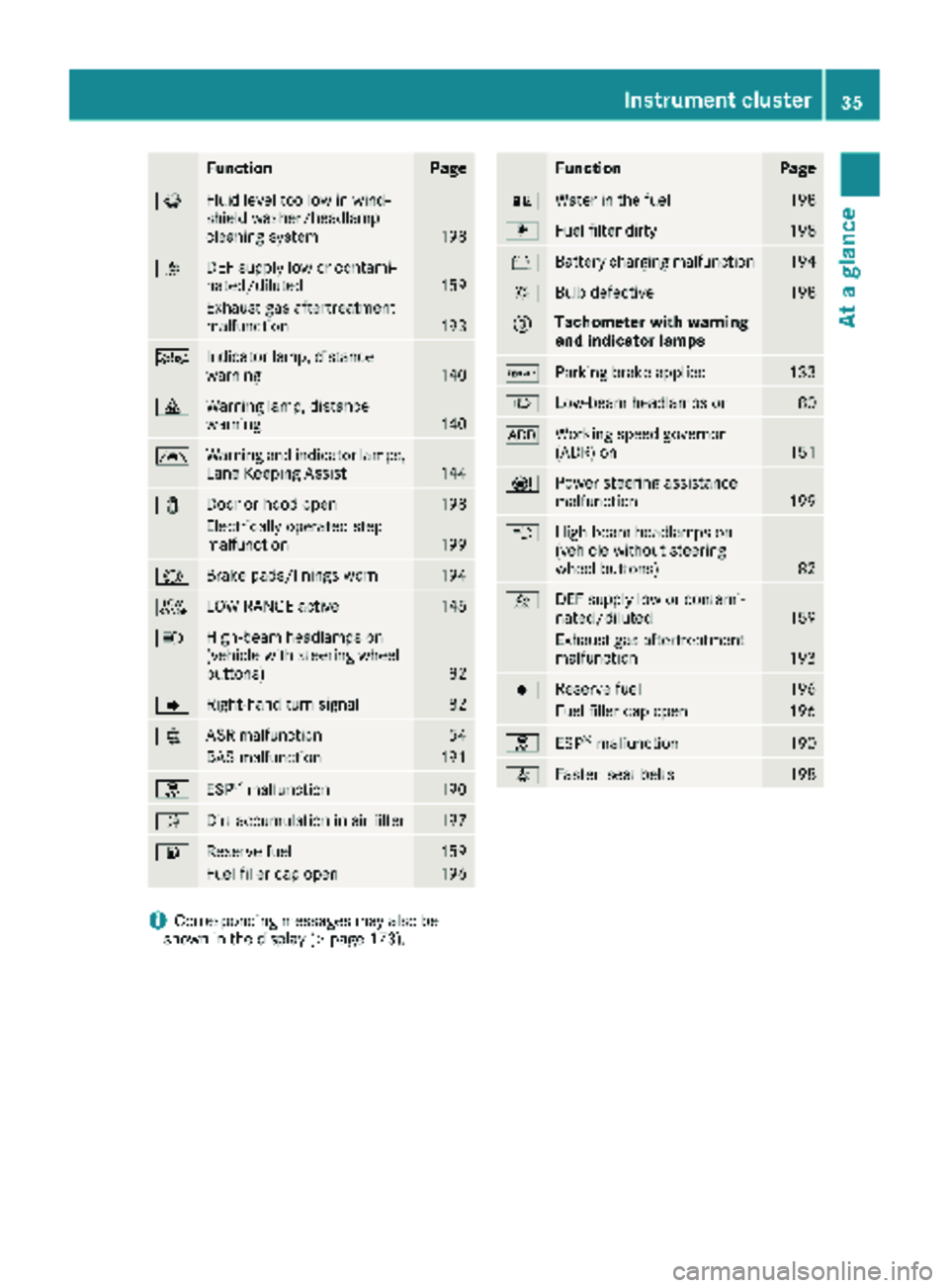
FunctionPage
¦Fluid level too low in wind-
shield washer/headlamp
cleaning system
198
åDEF supply low or contami-
nated/diluted159
Exhaust gas aftertreatment
malfunction193
ÄIndicator lamp, distance
warning140
·Warning lamp, distance
warning140
ÃWarning and indicator lamps,
Lane Keeping Assist144
1Door or hood open198
Electrically operated step
malfunction199
#Brake pads/linings worn194
+LOW RANGE active145
KHigh-beam headlamps on
(vehicle with steering wheel
buttons)
82
JRight-hand turn signal82
:ASR malfunction54
BAS malfunction191
hESP®malfunction190
ÈDirt accumulation in air filter197
6Reserve fuel159
Fuel filler cap open196
FunctionPage
:Water in the fuel198
mFuel filter dirty198
#Battery charging malfunction194
bBulb defective198
=Tachometer with warning
and indicator lamps
cParking brake applied133
LLow-beam headlamps on80
KWorking speed governor
(ADR) on151
ÐPower steering assistance
malfunction199
KHigh-beam headlamps on
(vehicle without steering
wheel buttons)
82
åDEF supply low or contami-
nated/diluted159
Exhaust gas aftertreatment
malfunction193
|Reserve fuel196
Fuel filler cap open196
hESP®malfunction190
7Fasten seat belts198
iCorresponding messages may also be
shown in the display (Ypage 173).
Instrument cluster35
At a glance
Page 59 of 286
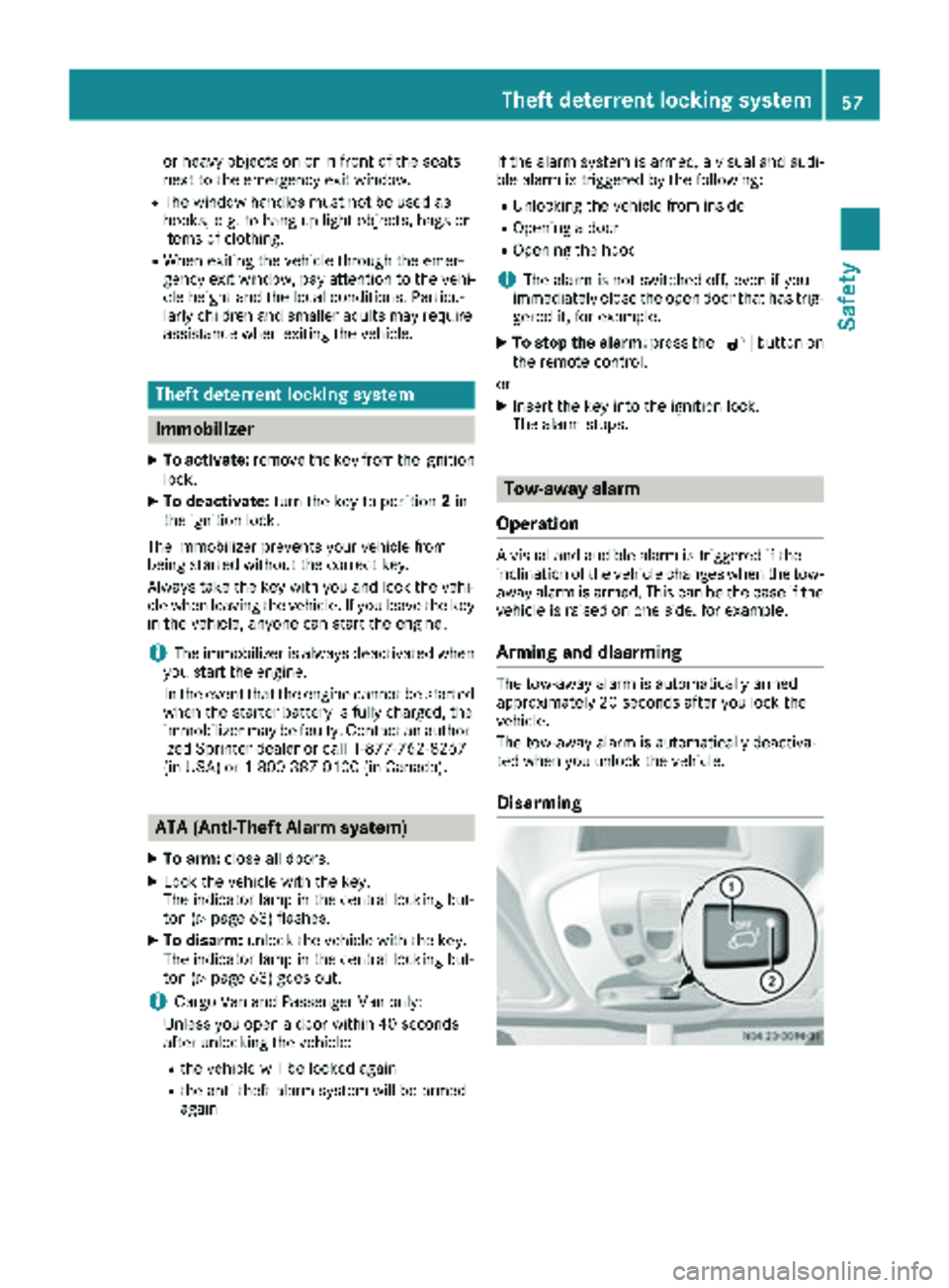
or heavy objects on or in front of the seats
next to the emergency exit window.
RThe window handles must not be used as
hooks, e.g. to hang up light objects, bags or
items of clothing.
RWhen exiting the vehicle through the emer-
gency exit window, pay attention to the vehi-
cle height and the local conditions. Particu-
larly children and smaller adults may require
assistance when exiting the vehicle.
Theft deterrent locking system
Immobilizer
XTo activate:remove the key from the ignition
lock.
XTo deactivate: turn the key to position 2in
the ignition lock.
The immobilizer prevents your vehicle from
being started without the correct key.
Always take the key with you and lock the vehi-
cle when leaving the vehicle. If you leave the key
in the vehicle, anyone can start the engine.
iThe immobilizer is always deactivated when
you start the engine.
In the event that the engine cannot be started
when the starter battery is fully charged, the
immobilizer may be faulty. Contact an author-
ized Sprinter dealer or call 1-877-762-8267
(in USA) or 1-800-387-0100 (in Canada).
ATA (Anti-Theft Alarm system)
XTo arm: close all doors.
XLock the vehicle with the key.
The indicator lamp in the central locking but-
ton (
Ypage 63) flashes.
XTo disarm: unlock the vehicle with the key.
The indicator lamp in the central locking but-
ton (
Ypage 63) goes out.
iCargo Van and Passenger Van only:
Unless you open a door within 40 seconds
after unlocking the vehicle:
Rthe vehicle will be locked again
Rthe anti-theft alarm system will be armed
again If the alarm system is armed, a visual and audi-
ble alarm is triggered by the following:
RUnlocking the vehicle from inside
ROpening a door
ROpening the hood
iThe alarm is not switched off, even if you
immediately close the open door that has trig- gered it, for example.
XTo stop the alarm: press the%button on
the remote control.
or
XInsert the key into the ignition lock.
The alarm stops.
Tow-away alarm
Operation
A visual and audible alarm is triggered if the
inclination of the vehicle changes when the tow- away alarm is armed. This can be the case if the
vehicle is raised on one side, for example.
Arming and disarming
The tow-away alarm is automatically armed
approximately 20 seconds after you lock the
vehicle.
The tow-away alarm is automatically deactiva-
ted when you unlock the vehicle.
Disarming
Theft deterrent locking system57
Safety
Z
Page 90 of 286
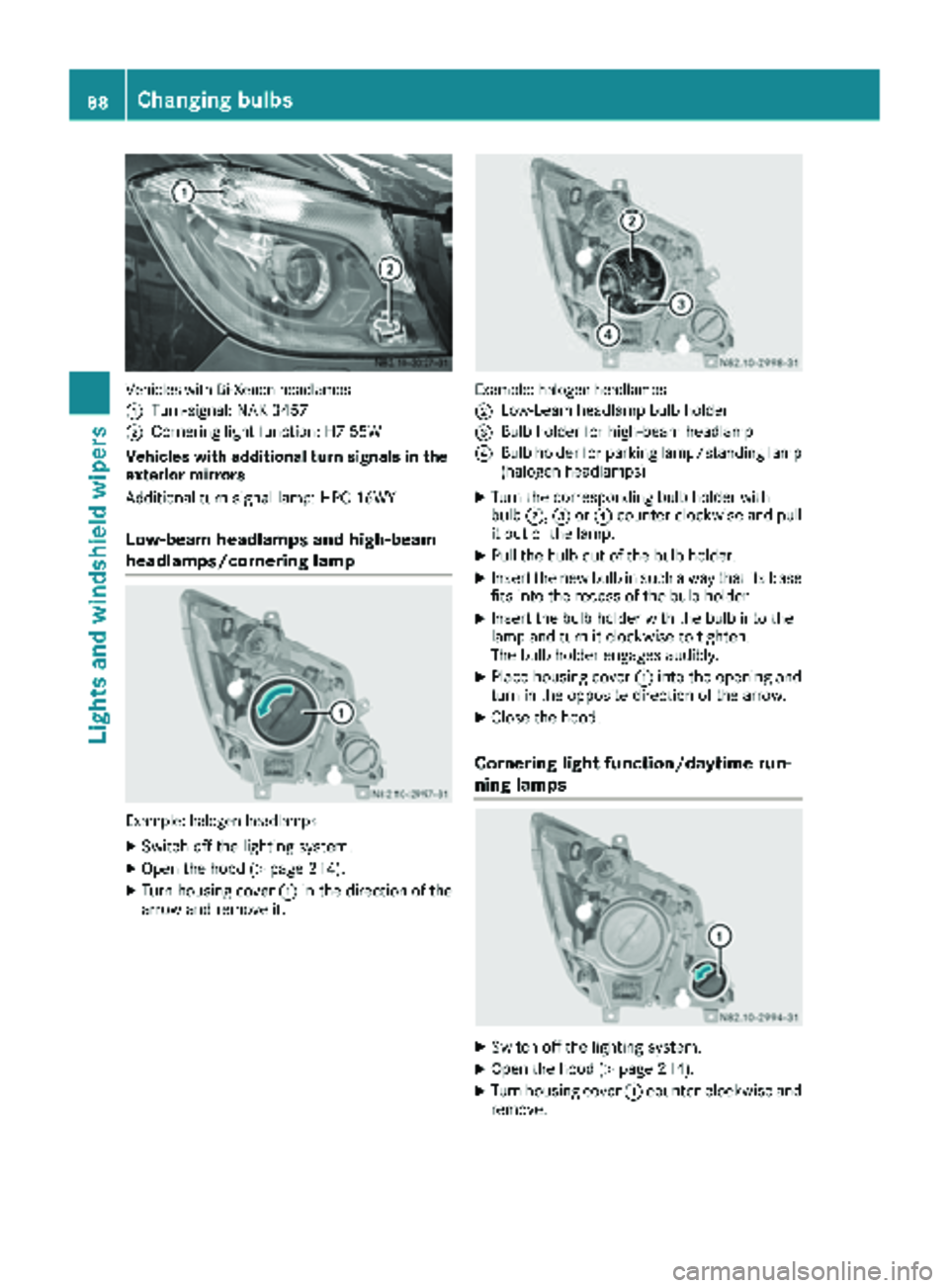
Vehicles with Bi-Xenon headlamps
:
Turn-signal: NAK 3457
;Cornering light function: H7 55W
Vehicles with additional turn signals in the
exterior mirrors
Additional turn signal lamp: HPC 16WY
Low-beam headlamps and high-beam
headlamps/cornering lamp
Example: halogen headlamps
XSwitch off the lighting system.
XOpen the hood (Ypage 214).
XTurn housing cover :in the direction of the
arrow and remove it.
Example: halogen headlamps
;
Low-beam headlamp bulb holder
=Bulb holder for high-beam headlamp
?Bulb holder for parking lamp/standing lamp
(halogen headlamps)
XTurn the corresponding bulb holder with
bulb ;,=or? counter-clockwise and pull
it out of the lamp.
XPull the bulb out of the bulb holder.
XInsert the new bulb in such a way that its base fits into the recess of the bulb holder.
XInsert the bulb holder with the bulb into the
lamp and turn it clockwise to tighten.
The bulb holder engages audibly.
XPlace housing cover :into the opening and
turn in the opposite direction of the arrow.
XClose the hood.
Cornering light function/daytime run-
ning lamps
XSwitch off the lighting system.
XOpen the hood (Ypage 214).
XTurn housing cover :counter-clockwise and
remove.
88Changing bulbs
Lights and windshield wipers
Page 91 of 286
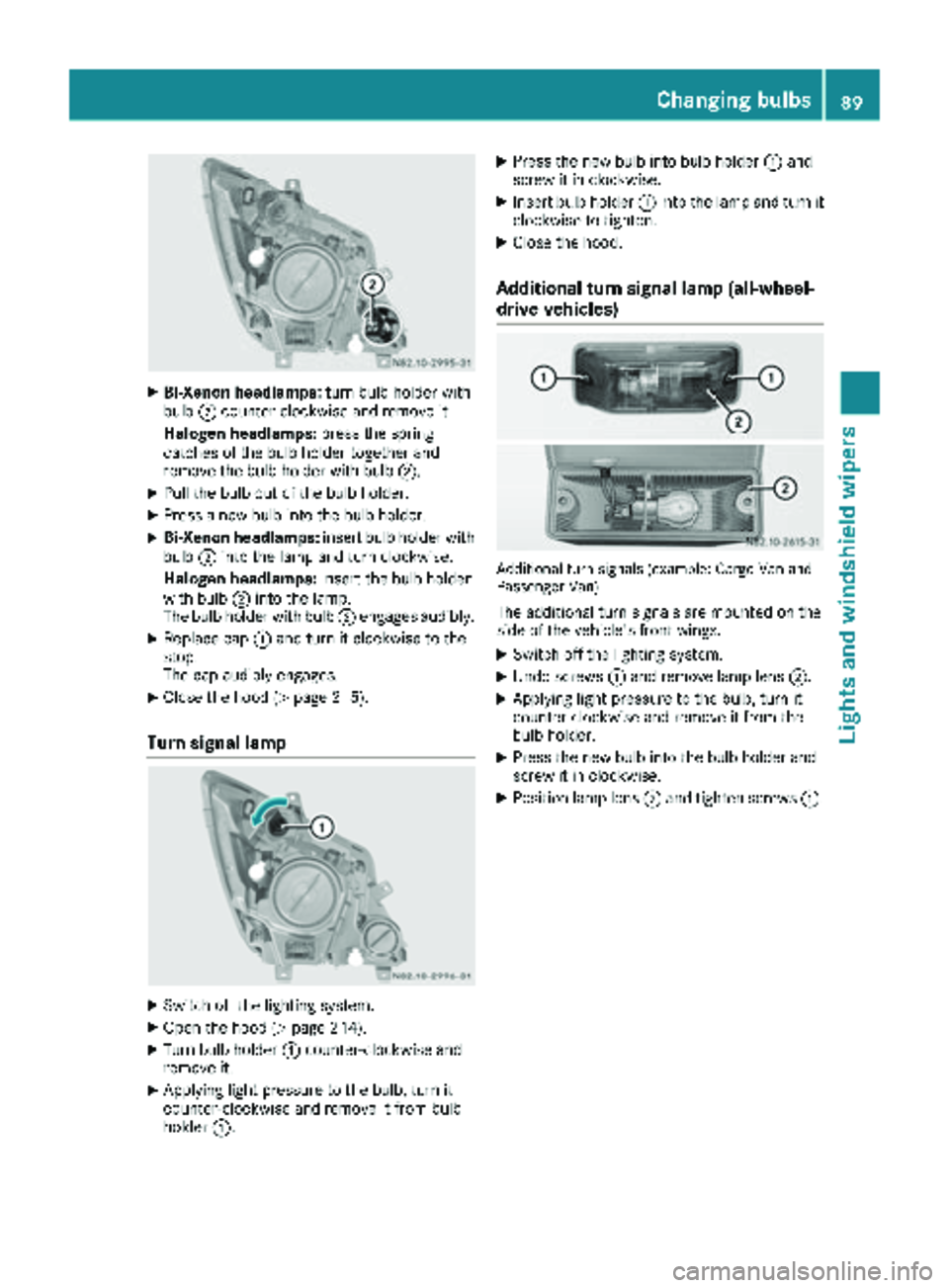
XBi-Xenon headlamps:turn bulb holder with
bulb ;counter-clockwise and remove it.
Halogen headlamps: press the spring
catches of the bulb holder together and
remove the bulb holder with bulb ;.
XPull the bulb out of the bulb holder.
XPress a new bulb into the bulb holder.
XBi-Xenon headlamps:insert bulb holder with
bulb ;into the lamp and turn clockwise.
Halogen headlamps: insert the bulb holder
with bulb ;into the lamp.
The bulb holder with bulb ;engages audibly.
XReplace cap :and turn it clockwise to the
stop.
The cap audibly engages.
XClose the hood (Ypage 215).
Turn signal lamp
XSwitch off the lighting system.
XOpen the hood (Ypage 214).
XTurn bulb holder :counter-clockwise and
remove it.
XApplying light pressure to the bulb, turn it
counter-clockwise and remove it from bulb
holder :.
XPress the new bulb into bulb holder :and
screw it in clockwise.
XInsert bulb holder :into the lamp and turn it
clockwise to tighten.
XClose the hood.
Additional turn signal lamp (all-wheel-
drive vehicles)
Additional turn signals (example: Cargo Van and
Passenger Van)
The additional turn signals are mounted on the
side of the vehicle's front wings.
XSwitch off the lighting system.
XUndo screws :and remove lamp lens ;.
XApplying light pressure to the bulb, turn it
counter-clockwise and remove it from the
bulb holder.
XPress the new bulb into the bulb holder and
screw it in clockwise.
XPosition lamp lens;and tighten screws :.
Changing bulbs89
Lights and windshield wipers
Z
Page 97 of 286
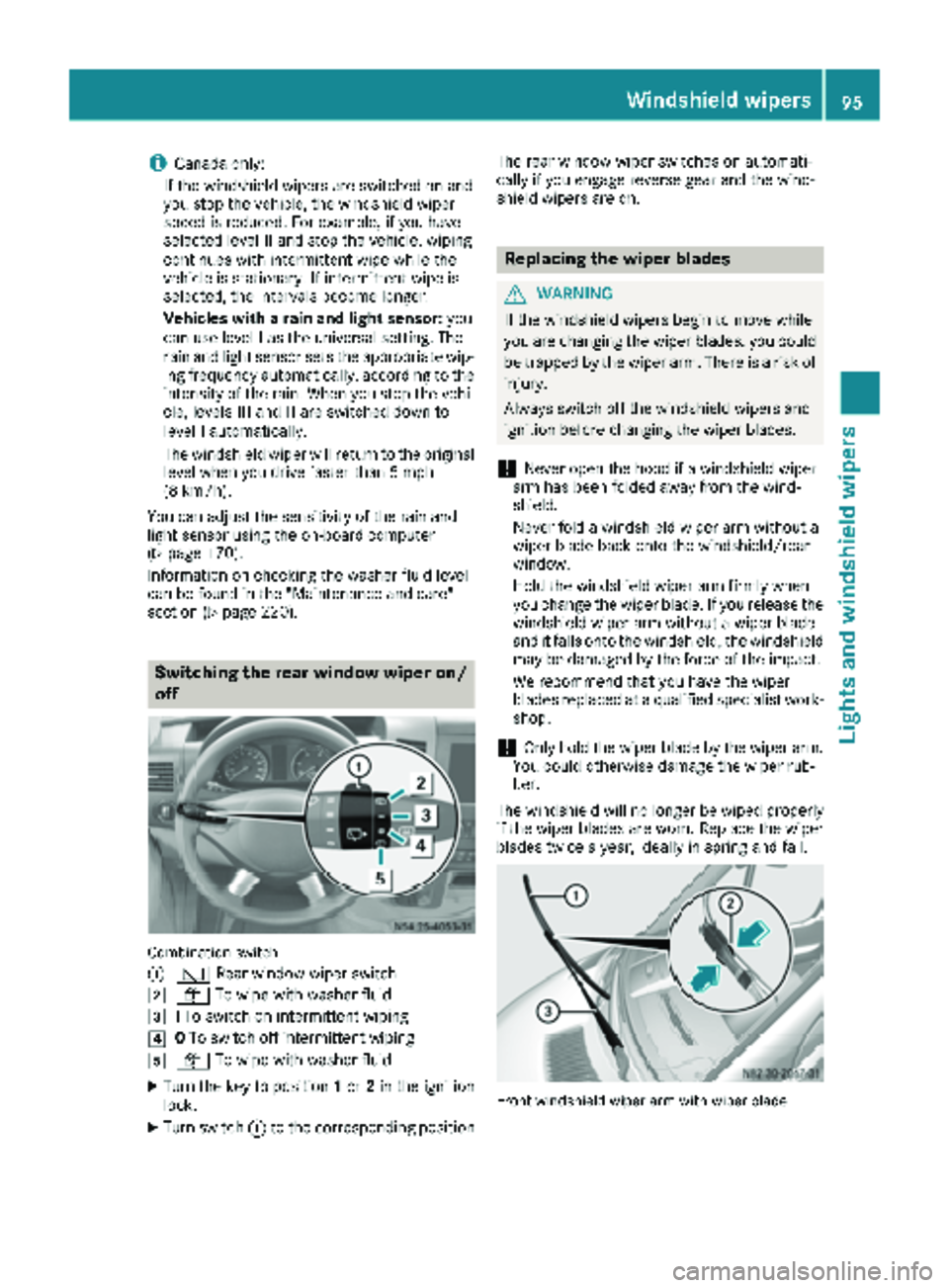
iCanada only:
If the wind shield wiper s areswitched on and
you stop the veh icle, the windshield wiper
speed isreduced. For example, ifyou have
selected level IIand stop the veh icle,wipin g
continues with intermittent wipe whilethe
veh icle is stationary. Ifintermittent wipe is
selected, the intervals become longer.
Vehicles with a rain and light sensor: you
can use level Ias the universal setting. The
rain and light sensor sets the appropriate wip-
ing frequency automatically, according to the
intensity of the rain. When you stop the veh i-
cle, leve lsIII and IIare swit ched down to
level Iautomatically.
The wind shield wiper will return to the original
level when you drive faster than 5 mph
(8 km/h).
You can adjust the sensitivit y of the rain and
light sensor using the on-board computer
(
Ypage 170).
In formation on checking the washer fluid level
can befound inthe "Maintenance and care"
section (
Ypage 220).
Switching the rear window wiper on/
off
Combination switch
:
è Rearwindowwiper swit ch
2ôTowipe wit h washer fluid
3ITo swit ch on intermittent wiping
40To swit ch off intermittent wiping
5ô Towipe wit h washer fluid
XTurn the key to position 1or 2in the ignition
lock.
XTurn switch: to the corresponding position The rear window wiper
switches on automati-
cally if you engage reverse gear and the wind-
shield wiper s are on.
Replacing the wiper blades
GWARNING
If the wind shield wipers begin to move while
you are changing the wiperblades, you could
be trapped by the wiper arm. There isa risk of
injury.
Always switch off the windshield wipers and
ignition before changing the wiper blades.
!Never open the hood if a windshield wiper
arm has been folded away from the wind-
shield.
Never fold a windshield wiper armwithout a
wiper blade back onto the windshield/rear
wind ow.
Hold the windshield wiper arm firmly when
you change the wiper blade. If you release the
windshield wiper arm without a wiperblade
and itfalls onto the windshield, the windshield
may be damaged by the force of the impact.
We recommend that you have the wiper
blades replaced at a qualified specialist work-
shop.
!Only hold the wiperblade by the wiperarm.
You could otherwise damage the wiper rub-
ber.
The wind shield will no longerbe wipedproperly
if the wiper blades are worn. Replace the wiper
blades twice a year, ideally in spring and fall.
Fron twindshield wiper arm wit hwiper blade
Windshield wipers95
Lights and windshield wipers
Z
Page 106 of 286
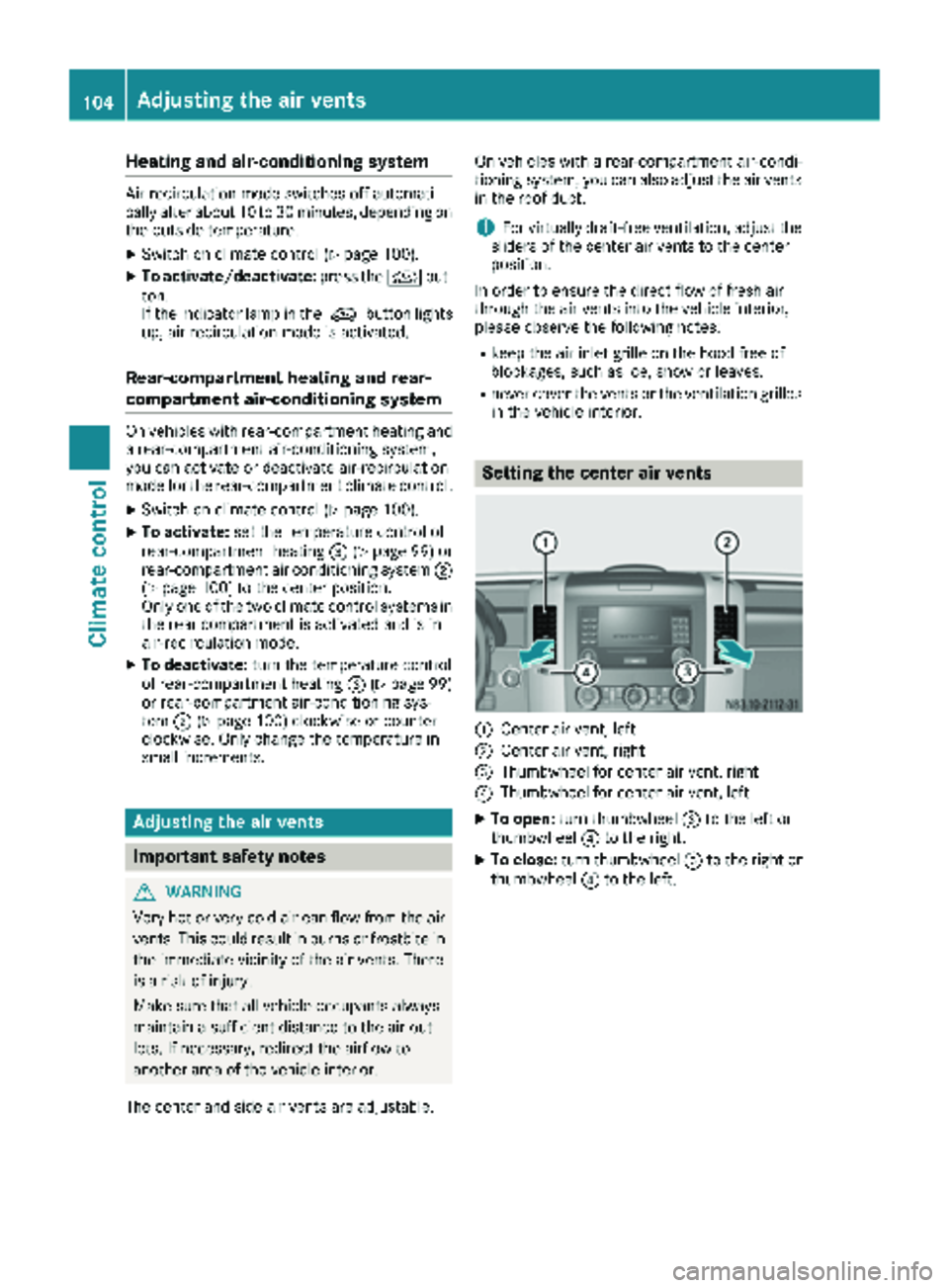
Heating and air-conditioning system
Air-recirculation mode switches off automati-
cally after about 10 to 30 minutes, depending on
the outside temperature.
XSwitch on climate control (Ypage 100).
XTo activate/deactivate:press theebut-
ton.
If the indicator lamp in the ebutton lights
up, air-recirculation mode is activated.
Rear-compartment heating and rear-
compartment air-conditioning system
On vehicles with rear-compartment heating and
a rear-compartment air-conditioning system,
you can activate or deactivate air-recirculation
mode for the rear-compartment climate control.
XSwitch on climate control (Ypage 100).
XTo activate: set the temperature control of
rear-compartment heating =(Ypage 99) or
rear-compartment air conditioning system ;
(
Ypage 100) to the center position.
Only one of the two climate control systems in
the rear compartment is activated and is in
air-recirculation mode.
XTo deactivate: turn the temperature control
of rear-compartment heating =(Ypage 99)
or rear-compartment air-conditioning sys-
tem ;(
Ypage 100) clockwise or counter-
clockwise. Only change the temperature in
small increments.
Adjusting the air vents
Important safety notes
GWARNING
Very hot or very cold air can flow from the air
vents. This could result in burns or frostbite in
the immediate vicinity of the air vents. There
is a risk of injury.
Make sure that all vehicle occupants always
maintain a sufficient distance to the air out-
lets. If necessary, redirect the airflow to
another area of the vehicle interior.
The center and side air vents are adjustable. On vehicles with a rear-compartment air-condi-
tioning system, you can also adjust the air vents
in the roof duct.
iFor virtually draft-free ventilation, adjust the
sliders of the center air vents to the center
position.
In order to ensure the direct flow of fresh air
through the air vents into the vehicle interior,
please observe the following notes:
Rkeep the air inlet grille on the hood free of
blockages, such as ice, snow or leaves.
Rnever cover the vents or the ventilation grilles
in the vehicle interior.
Setting the center air vents
:Center air vent, left
;Center air vent, right
=Thumbwheel for center air vent, right
?Thumbwheel for center air vent, left
XTo open: turn thumbwheel =to the left or
thumbwheel ?to the right.
XTo close: turn thumbwheel =to the right or
thumbwheel ?to the left.
104Adjusting the air vents
Climate control
Page 128 of 286
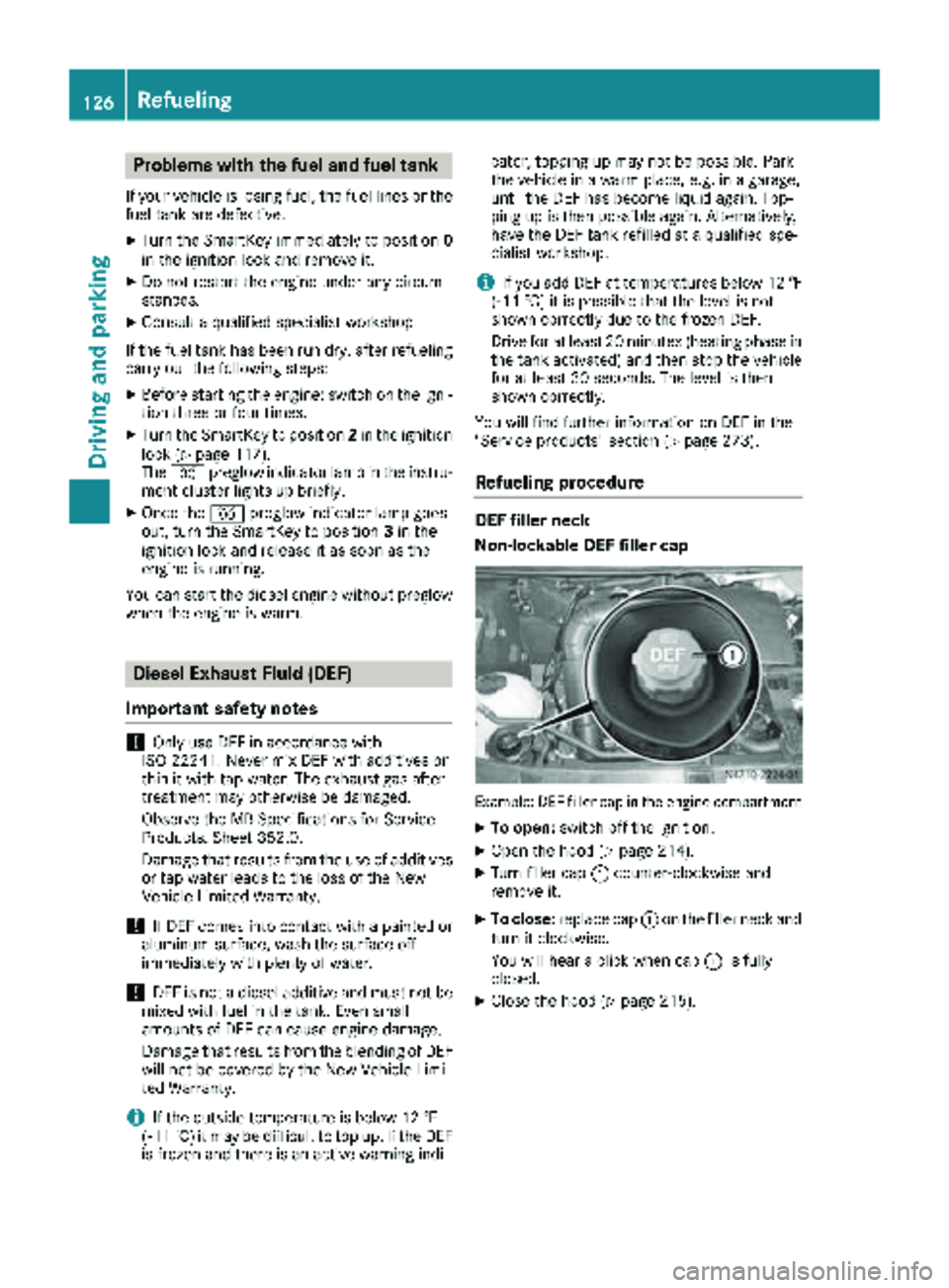
Problems with the fuel and fuel tank
If your vehicle is losing fuel, the fuel lines or thefuel tank are defective.
XTurn the SmartKey immediately to position 0
in the ignition lock and remove it.
XDo not restart the engine under any circum-
stances.
XConsult a qualified specialist workshop.
If the fuel tank has been run dry, after refueling
carry out the following steps:
XBefore starting the engine: switch on the igni-
tion three or four times.
XTurn the SmartKey to position 2in the ignition
lock (Ypage 117).
The % preglow indicator lamp in the instru-
ment cluster lights up briefly.
XOnce the %preglow indicator lamp goes
out, turn the SmartKey to position 3in the
ignition lock and release it as soon as the
engine is running.
You can start the diesel engine without preglow
when the engine is warm.
Diesel Exhaust Fluid (DEF)
Important safety notes
!Only use DEF in accordance with
ISO 22241. Never mix DEF with additives or
thin it with tap water. The exhaust gas after-
treatment may otherwise be damaged.
Observe the MB Specifications for Service
Products, Sheet 352.0.
Damage that results from the use of additives
or tap water leads to the loss of the New
Vehicle Limited Warranty.
!If DEF comes into contact with a painted or
aluminum surface, wash the surface off
immediately with plenty of water.
!DEF is not a diesel additive and must not be
mixed with fuel in the tank. Even small
amounts of DEF can cause engine damage.
Damage that results from the blending of DEF
will not be covered by the New Vehicle Limi-
ted Warranty.
iIf the outside temperature is below 12 ‡
(Ò11 †) it may be difficult to top up. If the DEF
is frozen and there is an active warning indi- cator, topping up may not be possible. Park
the vehicle in a warm place, e.g. in a garage,
until the DEF has become liquid again. Top-
ping up is then possible again. Alternatively,
have the DEF tank refilled at a qualified spe-
cialist workshop.
iIf you add DEF at temperatures below 12 ‡
(Ò11 †) it is possible that the level is not
shown correctly due to the frozen DEF.
Drive for at least 20 minutes (heating phase in
the tank activated) and then stop the vehicle
for at least 30 seconds. The level is then
shown correctly.
You will find further information on DEF in the
"Service products" section (
Ypage 273).
Refueling procedure
DEF filler neck
Non-lockable DEF filler cap
Example: DEF filler cap in the engine compartment
XTo open: switch off the ignition.
XOpen the hood (Ypage 214).
XTurn filler cap :counter-clockwise and
remove it.
XTo close: replace cap :on the filler neck and
turn it clockwise.
You will hear a click when cap :is fully
closed.
XClose the hood (Ypage 215).
126Refueling
Driving and parking
Page 129 of 286
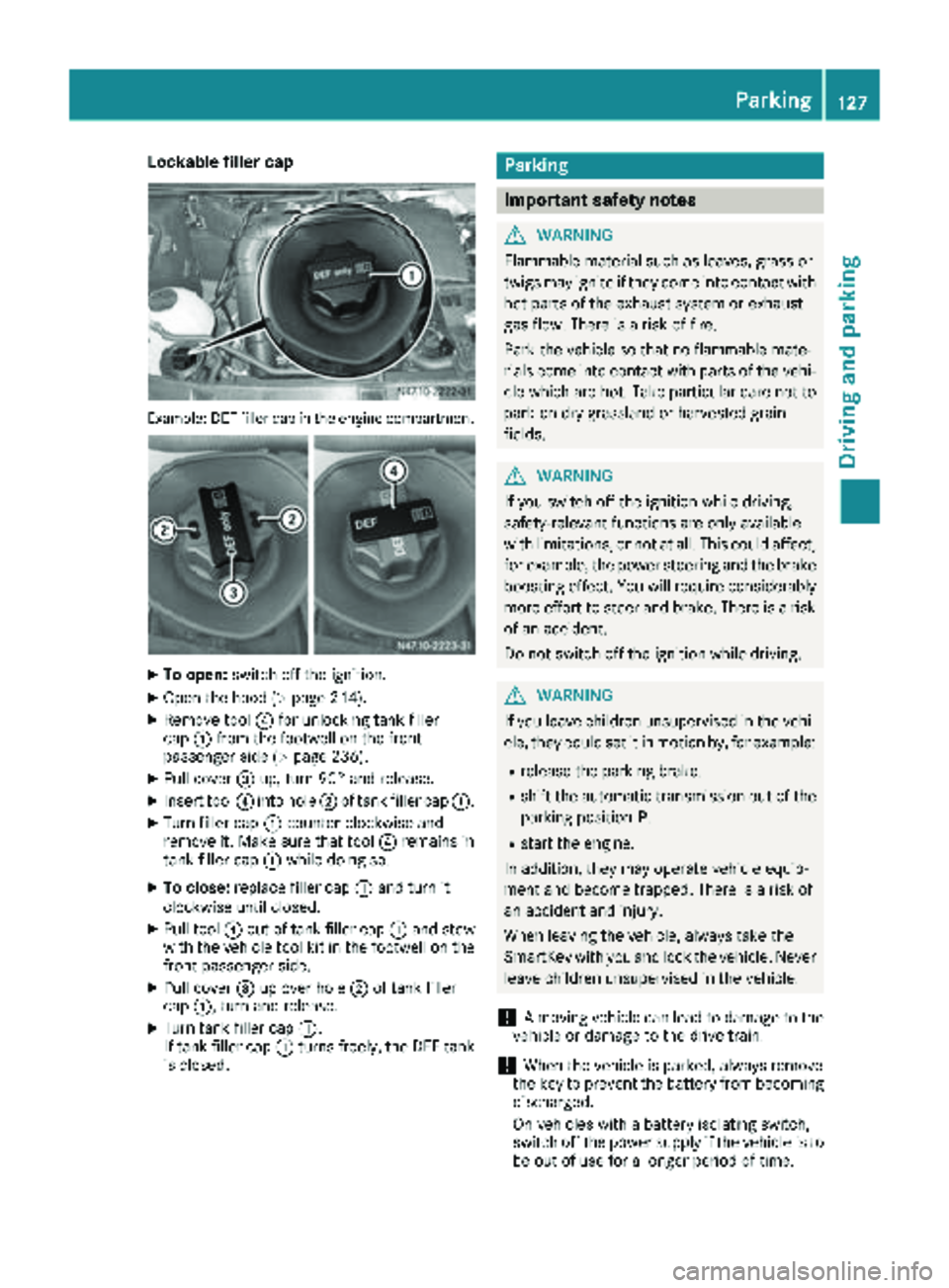
Lockable filler cap
Example: DEF filler cap in the engine compartment
XTo open:switch off the ignition.
XOpen the hood (Ypage 214).
XRemove tool ?for unlocking tank filler
cap :from the footwell on the front-
passenger side (
Ypage 236).
XPull cover =up, turn 90° and release.
XInsert tool ?into hole ;of tank filler cap :.
XTurn filler cap:counter-clockwise and
remove it. Make sure that tool ?remains in
tank filler cap :while doing so.
XTo close: replace filler cap :and turn it
clockwise until closed.
XPull tool ?out of tank filler cap :and stow
with the vehicle tool kit in the footwell on the
front-passenger side.
XPull cover =up over hole ;of tank filler
cap :, turn and release.
XTurn tank filler cap :.
If tank filler cap :turns freely, the DEF tank
is closed.
Parking
Important safety notes
GWARNING
Flammable material such as leaves, grass or
twigs may ignite if they come into contact with
hot parts of the exhaust system or exhaust
gas flow. There is a risk of fire.
Park the vehicle so that no flammable mate-
rials come into contact with parts of the vehi-
cle which are hot. Take particular care not to
park on dry grassland or harvested grain
fields.
GWARNING
If you switch off the ignition while driving,
safety-relevant functions are only available
with limitations, or not at all. This could affect, for example, the power steering and the brake
boosting effect. You will require considerably
more effort to steer and brake. There is a risk
of an accident.
Do not switch off the ignition while driving.
GWARNING
If you leave children unsupervised in the vehi-
cle, they could set it in motion by, for example:
Rrelease the parking brake.
Rshift the automatic transmission out of the
parking position P.
Rstart the engine.
In addition, they may operate vehicle equip-
ment and become trapped. There is a risk of
an accident and injury.
When leaving the vehicle, always take the
SmartKey with you and lock the vehicle. Never
leave children unsupervised in the vehicle.
!A moving vehicle can lead to damage to the
vehicle or damage to the drive train.
!When the vehicle is parked, always remove
the key to prevent the battery from becoming
discharged.
On vehicles with a battery isolating switch,
switch off the power supply if the vehicle is to
be out of use for a longer period of time.
Parking127
Driving and parking
Z